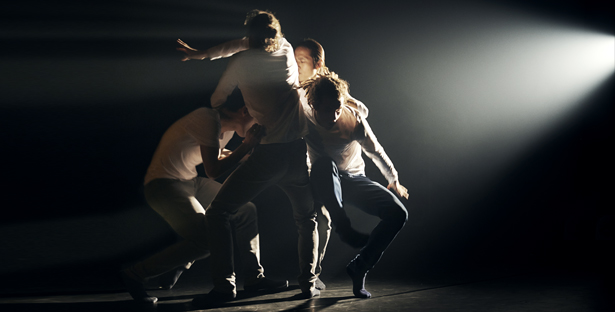Contemporary dance is as fluid as ever, crossing into many art forms, and contemporary dance artists are succumbing to the endless screams of people wanting something ‘fresh, innovative and creative’.
Associate artists of Sadler’s Wells: Kate Prince, Crystal Pite and Hofesh Schechter are experimenting with creations from unfamiliar territories to their previous works, to attempt to meet these expectations.
The Associates is advertised as a triple bill of works with no connection between the three artists. However, a common thread can be found in their wish to run from what is comfortable. Prince, Pite and Schechter all seem to be questioning the matter of self and how we exist and relate with others. A sharing like no other, bringing three, very different choreographers together and hopefully a tradition from Sadler’s Wells that can continue, supporting their associates to preview new ideas.
Hofesh Schechter
Stripping back from the raucous music and smokey realms of Schechter’s previous works, the barbarians in love is a sextet of plainly clothed dancers who physicalise his instantly recognisable movement vocabulary, which decorates the strictly structured Baroque sound score.
This piece feels like an initiation into a set of values that dictate how one should behave; better yet a commentary on the control of people in a hierarchical society. The dancers scream “I am not alone” and break from traditional, balletic lines, whilst a siri-like voice instructs rules of etiquette.

Their movement switches from straight, long limbed lines to hunched over and ferociously flinging themselves around the sparse space. A dry, sarcastic argument erupts from the speakers between the narrator and Schechter, expectedly finding his way into the work like so many of his others. Schechter contradicts cleanliness and innocence with an intense state of passion, which the human race cannot help but be overcome by. barbarians in love is a tasteful start to what could be in line to Schechter’s already established legacy.
Crystal Pite
Canadian born artist, Crystal Pite tests the waters of a London audience with A Picture of You Falling. This intimate duet is a revisitation of Pite’s, first “released in 2008 in the context of [her] company Kidd Pivot”. Peter Chu and Anna Plamondon revive their intertwined relationship, which is a fascination of Pite’s, who is “convinced by the shared narratives that live in our bodies”.
Tall lamps light the stage in a semi-circle and a female voiceover tells me that, “this is a picture of me”, immediately placing myself on the stage. Chu and Plamondon are puppets to the narrator, becoming a visual to this ‘picture of me’. Actions amalgamate as the pair come together, their stories overlapping after they are introduced separately.
Collapsing and rebounding from the locks of love, and the hard stage, Chu and Plamondon appear to show me how to pick myself up and carry on after I learn the “sound of [my] heart hitting the floor”. A Picture of You is well thought out by Pite, and being the first of a triple bill of works to be created (similar to Prince and Schechter), I am interested to witness what may happen next.

Kate Prince
Prince, Artistic Director of ZooNation Dance Company, tries to swerve from constructing her usual happy-go-lucky piece for all the family, delving into “the dark shadows behind Charlie Chaplin” in SMILE.
Prince is pensive about how such pressure is on comedians to be funny all the time, linking to the death of Robin Williams. Although, Prince admits that SMILE is a sugar-coated shadow of what she hopes it will develop into.
ZooNation company member, Tommy Franzén choreographed the piece, assisted by fellow member Shaun Smith. Franzén also performs this solo, delivering his usual hip hop theatre panache with charm, tumbling over furniture and manipulating the set, which is laid out like a dressing room.
However the point is made about feeling alone and distressed beyond the wings of a stage within the first half of SMILE, Franzén switching from slapstick humour to angst repetitively. The piece becomes lengthy and a skin-deep spectacle that you may expect on So You Think You Can Dance. Regardless the piece is a people pleaser and represents the more accessible side of contemporary dance for the first-time viewer.
Reviewed at Sadler’s Wells, 6 February.


